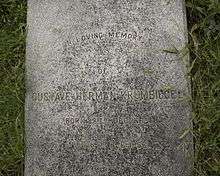Gustav Hermann Krumbiegel

Gustav Hermann Krumbiegel (18 December 1865, Lohmen, Kingdom of Saxony - 8 February 1956, Bangalore) was a German botanist and garden designer who was best known for his work at the Lal Bagh Botanical Gardens in Bangalore and for the planning of the avenues of Bangalore.
Life and work
Krumbiegel was born in Lohmen near Dresden, and his early studies were in Wilsdruff and Dresden after which he trained in horticulture in Pillnitz. In 1884 he worked in Schwerin and from 1885 to 1887 he worked as a landscape gardener in Hamburg. In 1888, he moved to England, designing flower beds at the Hyde Park and became a staff at the Royal Botanical Gardens in Kew.[1] He then took up a position in 1893 with the princely state of Baroda as Curator of the botanical gardens there.[2] He also worked with the Government Botanical Gardens at Ootacamund and was responsible for redesign of the architecture. In 1908 he was requested by Krishnaraja Wodeyar, the ruler of Mysore to serve him and he succeeded John Cameron at the Lal Bagh Gardens as an economic botanist and superintendent. He introduced numerous plants and was involved in the design of the Brindavan Gardens. He was also involved with the Mysore Horticultural Society that was started in 1912. Although outside his key work area, he was often involved in architectural design.[3] The Dewan of Mysore appointed him as an architectural consultant despite protests from the British Resident in Mysore. During the Second World War, Germans in India were declared as enemies and Krumbiegel was, along with other Germans, held at an internment camp in Bangalore.[4][5]
He obtained seeds from other countries and sent collections in return to Kew and the United States of America. These included Indian specialities such as bamboo rice, varieties of rice, mango and others.[6][7]
Apart from his work with horticulture and economic botany, he was responsible in the introduction of many ornamental plants and flowering trees and was involved in the choice of avenue trees for Bangalore. The road adjoining the Lal Bagh botanical garden is named after him as Krumbiegel road.
Later Years and Honours
After 1932, Krumbiegel continued to live in Bangalore, working as consulting architect and advisor in town planning and horticulture, till his death in 1956. He was buried at the Methodist cemetery on Hosur Road, Bangalore.
The Krumbiegel Road, located between Lalbagh and Mavalli is named after him. Suresh Jayaram wrote a book on his life named as `GH Krumbiegel: Whatever he touched, he adorned', which traces his life journey and legacy in Bangalore.[8][9]
60 years after his death, Krumbiegel's grave has been given a facelift by the government honoring his contributions.[10]
References
- ↑ Hayavadana Rao, C (1915). The Indian biographical dictionary. Pillar and Co, Madras. p. 240.
- ↑ Bulletin of Miscellaneous Information. Royal Botanic Gardens, Kew. p. 99.
- ↑ Aurobindo (1904). Autobiographical Notes and other writings of historical interest. The complete works of Sri Aurobindo. Volume 36. Sri Aurobindo Ashram Trust. p. 162.
- ↑ Letter from Chief Secretary to H. Trevelyan Esqr. Secretary to the Hon’ble Resident of Mysore - Enemy Foreigners: 1) G.H. Krumbiegal; 2) Dr. O. H. Koenigsberger; 3) Otto Schmidt; 4) Captain Charles Chimani, September 6, 1939, File No. 66-40, S. No.1-28, GOM War, KSA, Bangalore, Karnataka.
- ↑ Baweja, Vandana (2008). A Pre-history of Green Architecture: Otto Koenigsberger and Tropical Architecture, from Princely Mysore to Post-colonial London. Unpublished Ph D thesis, University of Michigan. hdl:2027.42/60709.
- ↑ Inventory of seeds and plants imported. USDA. 1916. p. 41.
- ↑ Anon. (1910). Seeds and plants introduced. USDA. p. 54.
- ↑ Shekhar, Divya (18 June 2015). "Hermann Krumbiegel, the German behind a blooming Bengaluru" (Bangalore). Economic Times. ET Bureau. Retrieved 12 August 2015.
- ↑ Jayaram, Suresh (20 March 2015). "What you see when you see: Whatever he touched, he adorned" (Bangalore). Bangalore Mirror. Bangalore Mirror Bureau. Retrieved 12 August 2015.
- ↑ "Krumbiegel's forgotten grave gets a facelift after 60 years". The Hindu. 2016-01-19. ISSN 0971-751X. Retrieved 2016-01-19.
Other sources
- Anon. Journal of the Mysore Horticultural Society, Issue 1, 1956 (obituary)